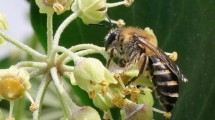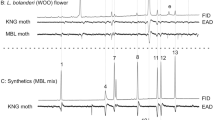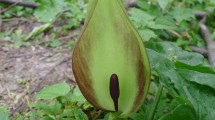Abstract
The pollen diet provided by adult bees to their offspring varies immensely. While some species collect pollen on several plants irrespective of their phylogenetic relatedness (polyleges), others collect only on plants within a genus or family (oligoleges). Floral scents play a central role in bee-plant interactions. To locate flowers, polyleges are assumed to rely on compounds commonly found as floral scent constituents, whereas oligoleges rely on unusual compounds to recognize host flowers unambiguously. Campanula flowers are visited by both polylectic and oligolectic species, and their scent bouquets consist of common and unusual (e.g., spiroacetals) volatiles. In a comparative approach, we performed electroantennographic analyses to investigate the antennal responses of three polyleges and three oligoleges to three common volatiles and four spiroacetals. We hypothesized that: 1) oligoleges and polyleges should respond similarly to common flower volatiles, and 2) Campanula oligoleges should be more sensitive to spiroacetals than are polyleges. In corroboration, we found that antennal sensitivity to common volatiles was similar among bees irrespective of pollen diet, whereas oligoleges of Campanula were more sensitive to spiroacetals than polyleges. Newly emerged bees of the Campanula oligolege Chelostoma rapunculi rely on spiroacetals for recognizing host-flowers, and our results suggest that this might also be true for other Campanula oligoleges, since Chelostoma campanularum and Hoplitis mitis also were able to perceive these specific volatiles at very low concentrations. Together, our results provide interesting insights into the significance of olfactory adaptations in oligolectic and polylectic bee species.





Similar content being viewed by others
References
Amiet F, Krebs A (2012) Bienen Mitteleuropas - Gattungen, Lebensweise, Beobachtung. P. 424. Haupt Verlag, Bern, Stuttgart, Wien.
Anderson MJ, Gorley RN, Clarke KR (2008) PERMANOVA+ for PRIMER: guide to software and statistical methods. PRIMER-E, Plymouth
Arenas A, Farina WM (2012) Learned olfactory cues affect pollen-foraging preferences in honeybees, Apis mellifera. Anim Behav 83:1023–1033
Ayasse M, Schiestl FP, Paulus HF, Löfstedt C, Hansson B, Ibarra F, Francke W (2000) Evolution of reproductive strategies in the sexually deceptive orchid Ophrys sphegodes: how does flower-specific variation of odor signals influence reproductive success? Evolution 54:1995–2006
Blionis GJ, Vokou D (2001) Pollination ecology of Campanula species on Mt Olympos, Greece. Ecography 24:287–297
Burger H, Dötterl S, Ayasse M (2010) Host-plant finding and recognition by visual and olfactory floral cues in an oligolectic bee. Funct Ecol 24:1234–1240
Burger H, Dötterl S, Häberlein C, Schulz S, Ayasse M (2012) An arthropod deterrent attracts specialised bees to their host plants. Oecologia 168:727–736
Cane JH, Sipes S (2006) Characterizing floral specialization by bees: analytical methods and revised lexicon for oligolecty. In: Waser NM, Ollerton J (eds) Plant-pollinator interactions: from specialization to generalization. The University of Chicago Press, Chicago, pp. 99–121
Chittka L, Kevan PG (2005) Flower colour as advertisement. In: Dafni A, Kevan PG, Husband BC (eds) Practical pollination biology. Enviroquest Ltd, Cambridge, pp. 157–196
Clarke D, Whitney H, Sutton G, Robert D (2013) Detection and learning of floral electric fields by bumblebees. Science 340:66–69
Dobson HEM (2006) Relationship between floral frangrance composition and type of pollinator. In: Dudareva N, Pichersky E (eds) Biology of floral scent. CRC Press, Boca Raton, pp. 147–198
Dobson HEM, Bergström G (2000) The ecology of pollen odors. Plant Syst Evol 222:63–87
Dötterl S, Vereecken JN (2010) The chemical ecology and evolution of bee-flower interactions: a review and perspectives. Can J Zool 88:668–697
Dötterl S, Füssel U, Jürgens A, Aas G (2005) 1,4-Dimethoxybenzene, a floral scent compound in willows that attracts an oligolectic bee. J Chem Ecol 31:2993–2998
Filella I, Primante C, Llusià J, Martín González AM, Seco R, Farré-Armengol G, Rodrigo A, Bosch J, Peñuelas J (2013) Floral advertisement scent in a changing plant-pollinators market. Sci Rep 3:3434
Heiduk A, Kong H, Brake I, von Tschirnhaus M, Tolasch T, Tröger AG, Wittenberg E, Francke W, Meve U, Dötterl S (2015) Deceptive Ceropegia dolichophylla fools its kleptoparasitic fly pollinators with exceptional floral scent. Front Ecol Evol 3:66
Kearns CA, Inouye DW, Waser NM (1998) Endangered mutualism: the conservation of plant-pollinator interactions. Annu Rev Ecol Syst 29:83–112
Kevan PG, Lane MA (1985) Flower petal microtexture is a tactile cue for bees. Proc Natl Acad Sci U S A 82:4750–4752
Knudsen JT, Eriksson R, Gershenzon J, Stahl B (2006) Diversity and distribution of floral scent. Bot Rev 72:1–120
Kovacic S (2004) The genus Campanula L. (Campanulaceae) in Croatia, circum-adriatic and West Balkan region. Acta Bot Croat 63:171–202
Leonard AS, Masek P (2014) Multisensory integration of colors and scents: insights from bees and flowers. J Comp Physiol A 200:463–474
Michener CD (2007) The bees of the world. The Johns Hopkins University Press, Baltimore, p. 992
Milet-Pinheiro P, Schlindwein C (2010) Mutual reproductive dependence of distylic Cordia leucocephala (Cordiaceae) and oligolectic Ceblurgus longipalpis (Halictidae, Rophitinae) in the Caatinga. Ann Bot 106:17–27
Milet-Pinheiro P, Ayasse M, Schlindwein C, Dobson HEM, Dötterl S (2012) Host location by visual and olfactory floral cues in an oligolectic bee: innate and learned behavior. Behav Ecol 23:531–538
Milet-Pinheiro P, Ayasse M, Dobson HEM, Schlindwein C, Francke W, Dötterl S (2013) The chemical basis of host-plant recognition in a specialized bee pollinator. J Chem Ecol 39:1347–1360
Milet-Pinheiro P, Ayasse M, Dötterl S (2015) Visual and olfactory floral cues of Campanula (Campanulaceae) and their significance for host recognition by an oligolectic bee pollinator. PLoS One 10:e0128577
Milet-Pinheiro P, Herz K, Dötterl S, Ayasse M (2016) Host choice in a bivoltine bee: how sensory constraints shape innate foraging behaviors. BMC Ecol 16:20
Pecetti L, Tava A, Felicioli A, Pinzauti M, Piano E (2002) Effect of three volatile compounds from lucerne flowers on their attractiveness towards pollinators. Bull Insectology 55:21–27
Praz CJ, Müller A, Danforth BN, Griswold TL, Widmer A, Dorn S (2008a) Phylogeny and biogeography of bees of the tribe Osmiini (hymenoptera: Megachilidae). Mol Phylogenet Evol 49:185–197
Praz CJ, Müller A, Dorn S (2008b) Specialized bees fail to develop on non-host pollen: do plants chemically protect their pollen. Ecology 89:795–804
Raguso RA (2001) Floral scent, olfaction, and scent-driven foraging behavior. In: Chittka L, Thomson JD (eds) Cognitive ecology of pollination. Cambridge University Press, Cambridge, pp. 83–105
Raguso RA (2004) Flowers as sensory billboards: progress towards an integrated understanding of floral advertisement. Curr Opin Plant Biol 7:434–440
Schäffler I, Steiner KE, Haid M, Van Berkel SS, Gerlach G, Johnson SD, Wessjohann L, Dötterl S (2015) Diacetin, a reliable cue and private communication channel in a specialized pollination system. Sci Rep 5:12779
Schiestl FP, Poll FM (2002) Detection of physiologically active flower volatiles using gas chromatography coupled with electroantennography. In: Jackson JF, Linskens HF, Inman R (eds) Molecular methods of plant analysis, volume 21: analysis of taste and aroma. Springer, Berlin, pp. 173–198
Schorkopf D, Mitko L, Eltz T (2011) Enantioselective preference and high antennal sensitivity for (−)-ipsdienol in scent-collecting male orchid bees, Euglossa cyanura. J Chem Ecol 37:953–960
Sedivy C, Praz CJ, Müller A, Widmer A, Dorn S (2008) Patterns of host-plant choice in bees of the genus Chelostoma: the constraint hypothesis of host-range evolution in bees. Evolution 62:2487–2507
Strausfeld CZ, Kaissling K-E (1986) Localized adaptation processes in olfactory sensilla of Saturniid moths. Chem Senses 11(4):499–512
Wadhams LJ (1990) The use of coupled gas chromatography: electrophysiological techniques in the identification of insect pheromones. In: Mccaffery AR, Wilson ID (eds) Chromatography and isolation of insect hormones and pheromones. Springer, US, pp. 289–298
Wadhams LJ, Blight MM, Kerguelen V, Le Métayer M, Marion-Poll F, Masson C, Pham-Delègue MH, Woodcock CM (1994) Discrimination of oilseed rape volatiles by honey bee: novel combined gas chromatographic-electrophysiological behavioral assay. J Chem Ecol 20:3221–3231
Westrich P (1989) Die Wildbienen Baden-Württembergs: Spezieller Teil: Die Gattungen und Arten. P. 437–972. Eugen Ulmer, Stuttgart.
Acknowledgments
We thank Peter Zindl and the whole team of the Botanical Garden of the University of Ulm for providing Campanula fields to rear the bees used in our experiments, Elisabeth Arnold for the management of bumblebee breeding, Sergei Dering for the photos used in this publication, and Robert R. Junker and Jutta Schmid for statistical advices. The German Science Foundation (DFG) financially supported this work (AY 12/5-1; DO 1250/6-1)
Author information
Authors and Affiliations
Corresponding author
Rights and permissions
About this article
Cite this article
Brandt, K., Dötterl, S., Francke, W. et al. Flower Visitors of Campanula: Are Oligoleges More Sensitive to Host-Specific Floral Scents Than Polyleges?. J Chem Ecol 43, 4–12 (2017). https://doi.org/10.1007/s10886-016-0802-z
Received:
Revised:
Accepted:
Published:
Issue Date:
DOI: https://doi.org/10.1007/s10886-016-0802-z




